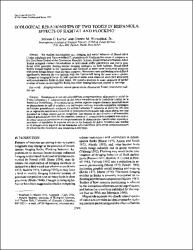Mostrar el registro sencillo del ítem
Ecological relationships of two todies in Hispaniola : effects of habitat and flocking
| Licencia | es | |
| Autor | Latta, Steven C. | |
| Autor | Wunderle, Joseph M. | |
| Fecha de admisión | 2022-08-06T20:32:59Z | |
| Fecha disponible | 2022-08-06T20:32:59Z | |
| Año | 1996 | |
| Citación | Latta, S. C., & Wunderle Jr, J. M. (1996). Ecological relationships of two todies in Hispaniola: effects of habitat and flocking. The Condor, 98(4), 769-779. Recuperado de: | es |
| URI | https://bvearmb.do/handle/123456789/1396 | |
| Sinopsis | We studied microhabitat use, foraging and social behavior of Broad-billed (Todus subulatus) and Narrow-billed (T. angustirostris) Todies in two areas o f sympatry in the Cordillera Central of the Dominican Republic. Solitary Broad-billed and Narrow-billed Todies occupied distinct microhabitats in both shade coffee plantations and native pine forest while generally sharing similar foraging strategies. In both habitats, Broad-billed Todies foraged higher in the vegetation and occurred in more outer horizontal positions with lower foliage density than did their congener. Movement rates and feeding rates differed significantly between the two species, with the Narrow-bill being the more active species. Changes in foraging behavior by both species of todies were observed when they associated with mixed-species flocks in pine forest. | en |
| Idioma | English | es |
| Publicado | The Condor, 98(4), 769-779 | es |
| Derechos | © The Cooper Ornithological Society, 1996. This article was written and prepared by U.S. Government employees on official time, and is therefore in the public domain. | es |
| Materia | Biodiversidad - República Dominicana | es |
| Materia | Hábitats y especies | es |
| Materia | Aves ─ República Dominicana | es |
| Título | Ecological relationships of two todies in Hispaniola : effects of habitat and flocking | en |
| dc.identifier.doi | 10.2307/1369857 | |
| Tipo de material | Article | es |
| Tipo de contenido | Scientific research | es |
| Acceso | Open | es |
| Audiencia | Technicians, professionals and scientists | es |
Ficheros en el ítem
Este ítem aparece en la(s) siguiente(s) colección(es)
-
Investigación ambiental [1693]


